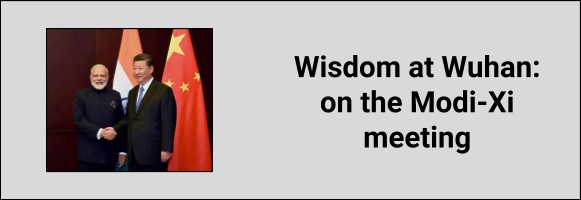(FREE) UPSC Current Affairs 2025 PDF
NEW! The Gist (SEP-2025) | E-BOOKS
Wisdom at Wuhan - On the Modi-Xi meeting : Important Topics for UPSC Exams

Wisdom at Wuhan - On the Modi-Xi meeting : Important Topics for UPSC Exams
Why in News?
- An ‘informal’ summit meeting (with no predefined agenda) between Prime Minister Narendra Modi and Chinese President Xi Jinping in Wuhan was recently concluded.
Significance of the Summit
- India-China relations have been under great stress in recent year and the 2017 military standoff at the Doklam tri-junction and the war of words that followed vitiated a relationship that was already reeling under a great deal of pressure.
- Summit was a much-needed one and will help in bringing the bilateral relations between the two Asian giants back on track and Wuhan was about the desire to return to the negotiating table, not about negotiating anything specific.
- India’s neighbourhood policy is in doldrums, India-Pakistan relationship nowhere normal and at the same time unsuccessful China Policy will prove to be the complete failure of Neighbourhood policy.
- It was informal, so no documentary significance was required for any agreement of great significance and thus Wuhan was chosen as a place for the summit to take place otherwise it would have been Beijing or Shanghai in case of Formal Meeting.
Timeline of the events
- After the Doklam standoff, in December 2017, the two Foreign Ministers met in New Delhi followed by a meeting between China’s then state councilor Yang Jiechi and Mr. Modi’s National Security Adviser, Ajit Doval, again in New Delhi.
- In February 2018, Foreign Secretary Vijay Gokhale visited China.
- The Wuhan summit was preceded by the visits of Foreign Minister Sushma Swaraj and Defence Minister Nirmala Sitharaman to China for Shanghai Cooperation Organisation (SCO) meetings.
Buy Printed Complete Study Materials for UPSC IAS PRELIMS Exam
Online Crash Course for UPSC PRE Exam
Outcomes of the Wuhan Summit
- The statements denoted the wide range of subjects discussed, from bilateral to regional and global challenges.
- India and China both sides maintain that there will be no tolerance for terrorism and that it is in the interest of both countries to collaborate.
- Both sides agreed offering innovative and sustainable solutions to global challenges such as epidemics, natural disasters, climate change and terrorism.
- On the bilateral front, they decided to “issue strategic guidance to their militaries to strengthen communication”, essentially to avoid another Doklam-like confrontation.
- Both sides addressed measures to better balance the ballooning trade deficit of about $52 billion (of about $84 billion bilateral trade), mostly by encouraging agricultural and pharmaceutical exports to China.
- Mr. Modi and Mr. Xi discussed a joint Economic project in Afghanistan. This could be instrumental in mitigating the trust deficit between the two sides. It has security side also involved with it as the lone Indian project may be attacked by Taliban but joint India- China project won’t be attacked by Taliban as Pakistan won’t allow that to happen.
- They attempted to reduce the heat over unresolved issues and so-called “irritants” in the relationship, such as China’s block on India’s NSG membership bid or the UN’s terror designation for Pakistan-based groups, and India’s opposition to the Belt and Road Initiative or its use of the Tibet issue. For this, existing mechanisms of dialogue will be strengthened, not allowing broader bilateral movement to be hit.
- The Wuhan summit has recommitted India and China to managing bilateral relations in a manner that creates the conditions for the “Asian Century”, and Mr. Modi and Mr. Xi are well-placed to proceed along that path.
India-China Relationship
- China is not like other neighbours of India, it is India’s biggest trading partner, and in many ways unavoidable from an economic and geopolitical point of view.
- Despite hundreds of years of engaging each other, the two neighbours have been to war only once; since the Agreement on the Maintenance of Peace and Tranquillity was signed in 1993, neither side has fired a weapon along the 3,500-km boundary, which is largely undemarcated.
- Despite both countries’ atomic weapons arsenals, discussions have never carried even a hint of the nuclear overhang.
- In 2013, New Delhi and Beijing signed the border defence cooperation agreement which aimed at maintaining peace along the Line of Actual Control.
- In 2015, during Mr. Modi’s visit to China, the two countries further agreed to “carry out annual visits and exchanges between the two Military Headquarters and neighbouring military commands, endeavour to operationalise the hotline between the two Military Headquarters, expand the exchanges between the border commanders, and establish border personnel meeting points at all sectors of the India-China border areas”.
- Many of these suggested measures have not yet been implemented, most notably, the hotline between the two-military headquarters.
Way forward
- The message from Wuhan is an overarching one: that despite bilateral and geopolitical differences, India and China can resolve differences peacefully and through prolonged dialogue.
MODEL QUESTIONS
Q. Recently an informal summit between India-China was held in Wuhan, which of the following statement is not correct?
A. Wuhan is a city in the central Europe.
B. Wuhan is a major industrial city.
C. Xinhai Revolution or the Chinese Revolution (1911) started from Wuhan.
D. Wuhan lies in the eastern Jianghan Plain on the middle reaches of the Yangtze River at the intersection of the Yangtze and Han rivers.
Answer-A

